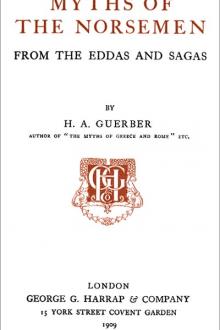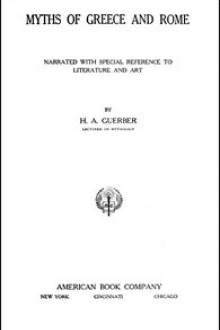Myths of the Norsemen, H. A. Guerber [ereader manga TXT] 📗

- Author: H. A. Guerber
- Performer: -
Book online «Myths of the Norsemen, H. A. Guerber [ereader manga TXT] 📗». Author H. A. Guerber
My mighty hammer, Miöllnir,
Shall stop thy prating.
I will thy head
From thy neck strike;
Then will thy life be ended.”
Ægir’s Compotation, or Loki’s Altercation (Thorpe’s tr.).
Knowing that he could now have no hope of being admitted into Asgard again, and that sooner or later the gods, seeing the effect of his evil deeds, would regret having permitted him to roam the world, and would try either to bind or slay him, Loki withdrew to the mountains, where he built himself a hut, with four doors which he always left wide open to permit of a hasty escape. Carefully laying his plans, he decided that if the gods should come in search of him he would rush down to the neighbouring cataract, according to tradition the Fraananger force or stream, and, changing himself into a salmon, would thus evade his pursuers. He reasoned, however, that although he could easily avoid any hook, it might be difficult for him to effect his escape if the gods should fashion a net like that of the sea-goddess Ran.
Haunted by this fear, he decided to test the possibility of making such a mesh, and started to make one out of twine. He was still engaged upon the task when Odin, Kvasir, and Thor suddenly appeared in the distance; and knowing that they had discovered his retreat, Loki threw his half-finished net into the fire, and, rushing through one of his ever-open doors, he leaped into the waterfall, where, in the shape of a salmon, he hid among some stones in the bed of the stream.
The gods, finding the hut empty, were about to depart, when Kvasir perceived the remains of the burnt net on the hearth. After some thought an inspiration came to him, and he advised the gods to weave a similar implement and use it in searching for their foe in the neighbouring stream, since it would be like Loki to choose such a method of baffling their pursuit. This advice seemed good and was immediately followed, and, the net finished, the gods proceeded to drag the stream. Loki eluded the net at its first cast by hiding at the bottom of the river between two stones; and when the gods weighted the mesh and tried a second time, he effected his escape by jumping up stream. A third attempt to secure him proved successful, however, for, as he once more tried to get away by a sudden leap, Thor caught him in mid-air and held him so fast, that he could not escape. The salmon, whose slipperiness is proverbial in the North, is noted for its remarkably slim tail, and Norsemen attribute this to Thor’s tight grasp upon his foe.
Loki now sullenly resumed his wonted shape, and his captors dragged him down into a cavern, where they made him fast, using as bonds the entrails of his son Narve, who had been torn to pieces by Vali, his brother, whom the gods had changed into a wolf for the purpose. One of these fetters was passed under Loki’s shoulders, and one under his loins, thereby securing him firmly hand and foot; but the gods, not feeling quite satisfied that the strips, tough and enduring though they were, would not give way, changed them into adamant or iron.
“Thee, on a rock’s point,
With the entrails of thy ice-cold son,
The gods will bind.”
Sæmund’s Edda (Thorpe’s tr.).
Skadi, the giantess, a personification of the cold mountain stream, who had joyfully watched the fettering of her foe (subterranean fire), now fastened a serpent directly over his head, so that its venom would fall, drop by drop, upon his upturned face. But Sigyn, Loki’s faithful wife, hurried with a cup to his side, and until the day of Ragnarok she remained by him, catching the drops as they fell, and never leaving her post except when her vessel was full, and she was obliged to empty it. Only during her short absences could the drops of venom fall upon Loki’s face, and then they caused such intense pain that he writhed with anguish, his efforts to get free shaking the earth and producing the earthquakes which so frighten mortals.
“Ere they left him in his anguish,
O’er his treacherous brow, ungrateful,
Skadi hung a serpent hateful,
Venom drops for aye distilling,
Every nerve with torment filling;
Thus shall he in horror languish.
By him, still unwearied kneeling,
Sigyn at his tortured side,—
Faithful wife! with beaker stealing
Drops of venom as they fall,—
Agonising poison all!
Sleepless, changeless, ever dealing
Comfort, will she still abide;
Only when the cup’s o’erflowing
Must fresh pain and smarting cause,
Swift, to void the beaker going,
Shall she in her watching pause.
Then doth Loki
Loudly cry;
Shrieks of terror,
Groans of horror,
Breaking forth in thunder peals
With his writhings scared Earth reels.
Trembling and quaking,
E’en high Heav’n shaking!
So wears he out his awful doom,
Until dread Ragnarok be come.”
Valhalla (J. C. Jones).
In this painful position Loki was destined to remain until the twilight of the gods, when his bonds would be loosed, and he would take part in the fatal conflict on the battlefield of Vigrid, falling at last by the hand of Heimdall, who would be slain at the same time.
Loki and Sigyn
M. E. Winge
As we have seen, the venom-dropping snake in this myth is the cold mountain stream, whose waters, falling from time to time upon subterranean fire, evaporate in steam, which escapes through fissures, and causes earthquakes and geysers, phenomena with which the inhabitants of Iceland, for instance, were very familiar.
When the gods were reduced to the rank of demons by the introduction of Christianity, Loki was confounded with Saturn, who had also been shorn of his divine attributes, and both were considered the prototypes of Satan. The last day of the week, which was held sacred to Loki, was known in the Norse as Laugardag, or wash-day, but in English it was changed to Saturday, and was said to owe its name not to Saturn but to Sataere, the thief in ambush, and the Teutonic god of agriculture, who is supposed to be merely another personification of Loki.
As we have already seen, the Northern races imagined that the giants were the first creatures who came to life among the icebergs which filled the vast abyss of Ginnunga-gap. These giants were from the very beginning the opponents and rivals of the gods, and as the latter were the personifications of all that is good and lovely, the former were representative of all that was ugly and evil.
“He comes—he comes—the Frost Spirit comes! on the rushing northern blast,
And the dark Norwegian pines have bowed as his fearful breath went past.
With an unscorched wing he has hurried on, where the fires on Hecla glow
On the darkly beautiful sky above and the ancient ice below.”
J. G. Whittier.
Thor and the Giants
M. E. Winge
When Ymir, the first giant, fell lifeless on the ice, slain by the gods, his progeny were drowned in his blood. One couple only, Bergelmir and his wife, effected their escape to Jötun-heim, where they took up their abode and became the parents of all the giant race. In the North the giants were called by various names, each having a particular meaning. Jötun, for instance, meant “the great eater,” for the giants were noted for their enormous appetites as well as for their uncommon size. They were fond of drinking as well as of eating, wherefore they were also called Thurses, a word which some writers claim had the same meaning as thirst; but others think they owed this name to the high towers (“turseis”) which they were supposed to have built. As the giants were antagonistic to the gods, the latter always strove to force them to remain in Jötun-heim, which was situated in the cold regions of the Pole. The giants were almost invariably worsted in their encounters with the gods, for they were heavy and slow-witted, and had nothing but stone weapons to oppose to the Æsir’s bronze. In spite of this inequality, however, they were sometimes greatly envied by the gods, for they were thoroughly conversant with all knowledge relating to the past. Even Odin was envious of this attribute, and no sooner had he secured it by a draught from Mimir’s spring than he hastened to Jötun-heim to measure himself against Vafthrudnir, the most learned of the giant brood. But he might never have succeeded in defeating his antagonist in this strange encounter had he not ceased inquiring about the past and propounded a question relating to the future.
Of all the gods Thor was most feared by the Jötuns, for he was continually waging war against the frost and mountain giants, who would fain have bound the earth for ever in their rigid bands, thus preventing men from tilling the soil. In fighting against them, Thor, as we have already seen, generally had recourse to his terrible hammer Miölnir.
According to German legends the uneven surface of the earth was due to the giants, who marred its smoothness by treading upon it while it was still soft and newly created, while streams were formed from the copious tears shed by the giantesses upon seeing the valleys made by their husbands’ huge footprints. As such was the Teutonic belief, the people imagined that the giants, who personified the mountains to them, were huge uncouth creatures, who could only move about in the darkness or fog, and were petrified as soon as the first rays of sunlight pierced through the gloom or scattered the clouds.
This belief led them to name one of their principal mountain chains the Riesengebirge (giant mountains). The Scandinavians also shared this belief, and to this day the Icelanders designate their highest mountain peaks by the name of Jokul, a modification of the word “Jötun.” In Switzerland, where the everlasting snows rest upon the lofty mountain tops, the people still relate old stories of the time when the giants roamed abroad; and when an avalanche came crashing down the mountain side, they say the giants have restlessly shaken off part of the icy burden from their brows and shoulders.
As the giants were also personifications of snow, ice, cold, stone, and subterranean fire, they were said to be descended from the primitive Fornjotnr, whom some authorities identify with Ymir. According to this version of the myth, Fornjotnr had three sons: Hler, the sea; Kari, the air; and Loki, fire. These three divinities, the first gods, formed the oldest trinity, and their respective descendants were the sea giants Mimir, Gymir, and Grendel, the storm giants Thiassi, Thrym, and Beli, and the giants of fire and death, such as the Fenris wolf and Hel.
As all the royal dynasties claimed descent from some mythical being, the Merovingians asserted that their first progenitor was a sea giant, who rose out of the waves in the form of an ox, and surprised the queen while she was walking alone on the seashore, compelling her to become his wife. She gave birth to a son named Meroveus, the founder of the first dynasty of Frankish kings.
Many stories have already been told about the most important giants. They reappear in many of the later myths and fairy-tales, and manifest, after the introduction of Christianity, a peculiar dislike to the sound of church bells and the singing of monks and nuns.





Comments (0)